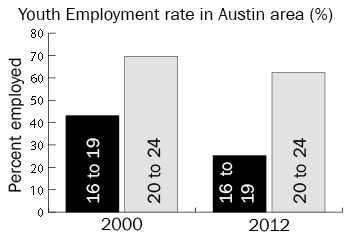Gov. Rick Perry has never been shy about singing Texas’ praises — not least since his presidential campaign a few years ago. Perry has spent the past few years traveling around the country trumpeting what he calls the “Texas miracle,” or the relative resilience of our economy in the financial crisis, to lure businesses to the state. In ads and speeches, Perry has touted the state’s low taxes and generally business friendly environment as incentives to set up shop in Texas. It’s impossible to know how many companies have been swayed by Perry’s rhetoric, but the movement of jobs to the state shows that many companies find Texas an attractive place to do business. From January 2013 to January 2014 alone, the state added 322,400 jobs.
All those new jobs translate into a low statewide unemployment rate. According to the Texas Workforce Commission, the unemployment rate stood at 5.7 percent in January, the lowest it had been since November 2008. But recent data from the Brookings Institution shows that in many of Texas’ largest metropolitan areas, including Austin-Round Rock, astonishingly high percentages of young people are being left out of the job market. In the Austin metropolitan area, the employment rate for 16- to 19-year-olds stands at 24.1 percent, while the employment rate for 20- to 24-year-olds comes in at 64.1 percent. Both of these figures put the city in the bottom half of the nation’s 100 largest metropolitan areas. For purposes of comparison, the San Antonio area had the 50th-highest employment rate for the younger group and 45th highest for the older group. The Houston area fared even worse, with a 77th-place ranking for the 16- to 19-year-olds and a 56th-place ranking for the 20- to 24-year-olds.
Source: Brookings
What this data shows is that while Perry may be happy with the state of the Texas economy, he’s forgetting about young Texans when he declares the health of the Texas economy a “miracle.” While the state continues to add jobs, they are clearly not reaching young people like they should.
Admittedly, the youth employment rate is always lower than the general employment rate, even in a good economy, according to Martha Ross, a fellow at the Metropolitan Policy Program in Washington, D.C., and a co-author of the report. This is especially true in areas with high numbers of college students, like Austin, or high numbers of high school dropouts, like the McAllen area, which posted the lowest employment rate for the 20- to 24-year-old age group. But while the statewide employment rate continues to rise, the youth employment rate has decreased significantly since 2000, particularly in the Austin area. As reported in the Austin American-Statesman, from 2000 to 2012, the employment rate for 16- to 19-year-olds in Central Texas fell by 17.8 percentage points, while the employment rate for 20- to 24-year-olds fell by 7.3 percentage points. Both of these decreases put the area dead last among Texas metropolitan areas.
But while the youth employment rate has its flaws as a measure of the health of the economy, the downward trends in Austin and disappointing youth labor markets in other major Texas cities cast a definite pall over the job searches of both current students and recent graduates of UT. Instead of trumpeting the universal success of the Texas economy, Perry should focus on those who haven’t benefited from the mass influx of jobs and search for ways to bring them into the fold. Luckily, he won’t be starting from square one. While there are no easy solutions to the youth unemployment problem in Texas, several groups are already trying to suss out its causes and bring it under control.
In Central Texas, one of those groups is the Greater Austin Chamber of Commerce.
Drew Scheberle, senior vice president of education and talent development, said Thursday that the chamber has been tracking the youth employment rate in the region and hasn’t figured out what’s keeping it so low.
“[The problem has] been on our radar for the past two years,” Scheberle said. “We haven’t been able to figure out why it’s happening, but once we figure that out, we can figure out how to address it.”
That’s not to say the Chamber of Commerce doesn’t have its theories. As Scheberle noted, the Austin area has created a significant number of jobs in retail and hospitality, but those jobs, which require little education, seem to be largely bypassing young people. Scheberle mentioned this trend in reference to local high school students, but given the local youth employment figures, it could just as well apply to college students.
The current state of the youth labor market in Texas defies easy explanations or solutions, but that doesn’t mean it’s a problem worth ignoring. Clearly, Texas has done well at attracting new jobs, but Perry needs to focus more on the problem of youth unemployment in Austin and throughout the state.

















